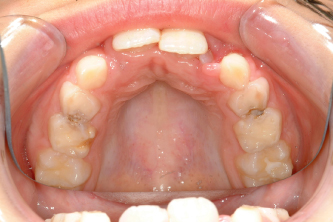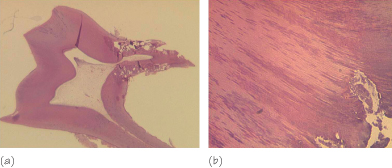21
Pulp Therapy
Diagnosis of Pulp Status
Pulp inflammation sets in early for proximal caries, and precedes the exposure of the pulp. There is evidence that pulp inflammation is already present in cases where proximal caries involves more than half the width of the marginal ridge (Fig. 21.1) or more than half the depth of dentine, even before the pulp is clinically exposed (Fig. 21.2). Bacteria can penetrate the wide dentinal tubules and reach the pulp ahead of the carious lesion and cause pulpal inflammation (Fig. 21.3). Also, history of pain and discomfort is carefully assessed. Pain that makes the child cry, lingers or wakes the child up at night is indicative of irreversible pulpitis.
Figure 21.1 Intra-oral photograph showing example of marginal ridge breakdown. The pulp in such cases is usually inflamed and a pulpotomy is required.

Figure 21.2 Relationship between extent of caries and pulp inflammation. It can be seen that in primary molars where caries has resulted in breakdown of the marginal ridge, even when the pulp is not clinically exposed pulp inflammation is already present in the pulp horn (Duggal et al, 2002).

Figure 21.3 Caries extending to half of the depth of dentine (a), but the bacteria have already penetrated the tubules through to the pulp (b).

Direct Pulp Capping
This is not considered for carious exposures in primary molars. A pulp exposed through the caries process is inflamed as discussed in previous sections.
Indirect Pulp Capping
See Chapter 23.
Pulpotomy
Pulpotomy involves the removal of coronal pulp which is deemed to be inflamed, thereby leaving the healthy radicular pulp in situ. A restoration that provides an excellent coronal seal to prevent reinfection of the remaining pulp tissue is then placed.
Indications
- Deep proximal caries.
- No history of spontaneous or persistent pain, or evidence of infection, such as furcation radiolucency (Fig. 21.4).
- Instances where extraction might not be desirable, such as in patients with />
Stay updated, free dental videos. Join our Telegram channel

VIDEdental - Online dental courses


